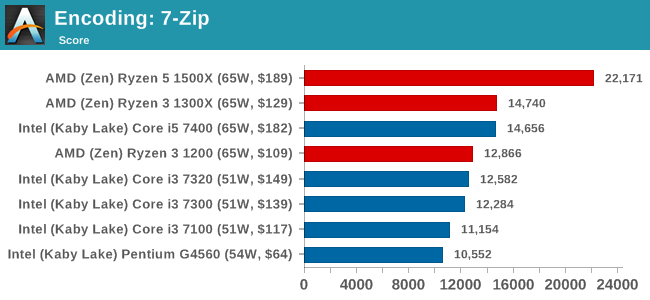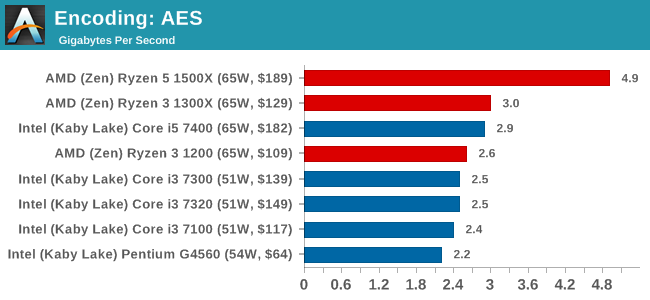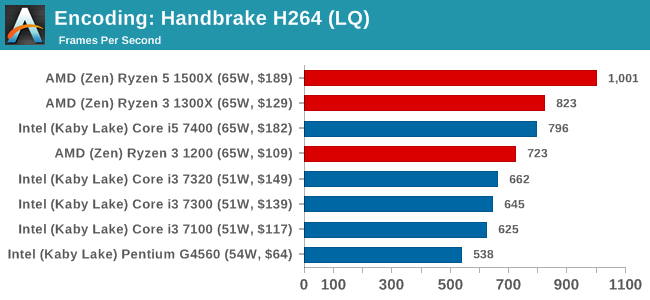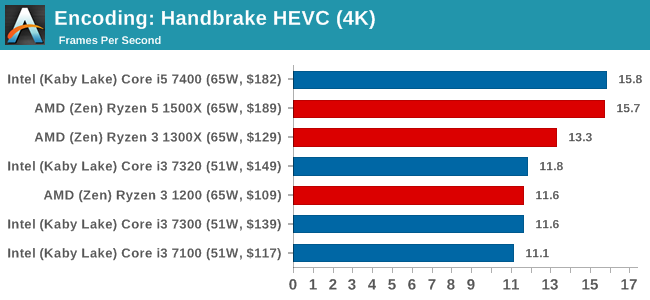The AMD Ryzen 3 1300X and Ryzen 3 1200 CPU Review: Zen on a Budget
by Ian Cutress on July 27, 2017 9:30 AM EST- Posted in
- CPUs
- AMD
- Zen
- Ryzen
- Ryzen 3
- Ryzen 3 1300X
- Ryzen 3 1200
Benchmarking Performance: CPU Encoding Tests
One of the interesting elements on modern processors is encoding performance. This includes encryption/decryption, as well as video transcoding from one video format to another. In the encrypt/decrypt scenario, this remains pertinent to on-the-fly encryption of sensitive data - a process by which more modern devices are leaning to for software security. Video transcoding as a tool to adjust the quality, file size and resolution of a video file has boomed in recent years, such as providing the optimum video for devices before consumption, or for game streamers who are wanting to upload the output from their video camera in real-time. As we move into live 3D video, this task will only get more strenuous, and it turns out that the performance of certain algorithms is a function of the input/output of the content.
All of our benchmark results can also be found in our benchmark engine, Bench.
7-Zip 9.2: link
One of the freeware compression tools that offers good scaling performance between processors is 7-Zip. It runs under an open-source licence, is fast, and easy to use tool for power users. We run the benchmark mode via the command line for four loops and take the output score.

WinRAR 5.40: link
For the 2017 test suite, we move to the latest version of WinRAR in our compression test. WinRAR in some quarters is more user-friendly that 7-Zip, hence its inclusion. Rather than use a benchmark mode as we did with 7-Zip, here we take a set of files representative of a generic stack (33 video files in 1.37 GB, 2834 smaller website files in 370 folders in 150 MB) of compressible and incompressible formats. The results shown are the time taken to encode the file. Due to DRAM caching, we run the test 10 times and take the average of the last five runs when the benchmark is in a steady state.

AES Encoding
Algorithms using AES coding have spread far and wide as a ubiquitous tool for encryption. Again, this is another CPU limited test, and modern CPUs have special AES pathways to accelerate their performance. We often see scaling in both frequency and cores with this benchmark. We use the latest version of TrueCrypt and run its benchmark mode over 1GB of in-DRAM data. Results shown are the GB/s average of encryption and decryption.

HandBrake v1.0.2 H264 and HEVC: link
As mentioned above, video transcoding (both encode and decode) is a hot topic in performance metrics as more and more content is being created. First consideration is the standard in which the video is encoded, which can be lossless or lossy, trade performance for file-size, trade quality for file-size, or all of the above can increase encoding rates to help accelerate decoding rates. Alongside Google's favorite codec, VP9, there are two others that are taking hold: H264, the older codec, is practically everywhere and is designed to be optimized for 1080p video, and HEVC (or H265) that is aimed to provide the same quality as H264 but at a lower file-size (or better quality for the same size). HEVC is important as 4K is streamed over the air, meaning less bits need to be transferred for the same quality content.
Handbrake is a favored tool for transcoding, and so our test regime takes care of three areas.
Low Quality/Resolution H264: He we transcode a 640x266 H264 rip of a 2 hour film, and change the encoding from Main profile to High profile, using the very-fast preset.

High Quality/Resolution H264: A similar test, but this time we take a ten-minute double 4K (3840x4320) file running at 60 Hz and transcode from Main to High, using the very-fast preset.

HEVC Test: Using the same video in HQ, we change the resolution and codec of the original video from 4K60 in H264 into 4K60 HEVC.











140 Comments
View All Comments
Gavin Bonshor - Thursday, July 27, 2017 - link
One of the hardest working men in the industry! :Dedlee - Thursday, July 27, 2017 - link
I dont understand the point of making a $100 cpu without an integrated gpu if you wanted to attract the lower end market, this is really silly mistake. Sort of like intel including an integrated gpu with i7-7700k, it doesnt make sense, 95% of those with a 7700k will buy a gpu, but someone who is looking for a lowend cpu is not going to buy a discrete graphics cards, its just sillyphoenix_rizzen - Thursday, July 27, 2017 - link
It really depends on the use case.For example, are there any integrated GPUs that support 3 monitors? I know a lot of them support dual monitors, but haven't come across any that support 3 (although I haven't looked that hard). My work PC is a low-profile desktop running an AMD Athlon-II x4 CPU and an Nvidia 730 GT GPU for tri-monitor setup. Upgrading the CPU/motherboard/RAM to a Ryzen 3 1300X would be a huge upgrade for this system.
90-odd % of the desktops in the schools here use AMD Athlon-II CPUs (graphics integrated into the chipset), with the rest using Intel Pentium CPUs (graphics integrated into the CPU). And we add Nvidia 210 or 730 GPUs to those that need better multi-monitor support or better 3D performance. Why do we do it that way? Cost. We try to keep the complete desktop system (case, motherboard,
CPU, at least 2 GB RAM, no storage of any kind) to under $200 CDN (they're diskless Linux stations). We have just shy of 5000 of those in the district right now.
We've avoided the Bulldozer-based APUs so far as the price/performance just wasn't there compared to the Pentium line (from our suppliers). But the Ryzen 3 looks like a decent upgrade. Will be interesting to see what the prices are like for it from our suppliers this winter/spring. Will also be interesting to see what the GPU side of the Zen-based APUs will be like next year.
The other important bit is driver support. We are a mostly Linux-using school district, so we tend to use hardware that's at least 2 steps back from the bleeding edge. That way, we get better prices, and better driver support.
edlee - Thursday, July 27, 2017 - link
i understand when upgrading from integrated to gpu like you stated in your use case, but from the low end price standpoint, a i3-7100 is cheaper because they dont need to add a gpu like the ryzen 3 needs, so its not competing on a performance standpoint or a price standpoint when you add the price of the cheapest gpuOutlander_04 - Friday, July 28, 2017 - link
Using an integrated gpu is usually a poor choice. Intels drivers are so dumbed down they are worse than hopeless.Factor in that using integrated means less system RAM available as well so performance can be reduced
Ratman6161 - Tuesday, August 1, 2017 - link
Many people may be starting out from the position of knowing that the integrated graphics on any of the Intel CPU's in the test are not good enough for them. If you know that from the start then the argument that AMD doesn't have an IGPU is meaningless. I'm also somewhat interested in seeing overclocking tests with the R3 as that is one thing you just don't get with Intel at this level short of the 7350K. I sort of suspect that an OC'd 1200 could but just as fast or faster than a 1300X (though at only a $20 difference I'm not sure how much it matters).Also, in more computationally intense tasks, the 1300x really doesn't do badly against the i5 that costs $53 more so once again, if you don't care about integrated graphics it could be a good choice for some people.
On the other hand, for someone for whom MS Office, email, and web browsing are their main uses, then something like the i3-7100 suddenly looks very attractive - or even the Pentium G.
In this segment, AMD really needs to get a Ryzen Based APU on the market. If they did a single CCX, 4 core and used the empty space vacated by the second CCX for a decent IGPU they could definitely have an i3 killer.
renw0rp - Thursday, July 27, 2017 - link
I had HP Folio 9470m with core i5-3437U and it was driving 3 * 1920x1200 screens without an issue. And it's ~2013 processor...3rd gen of Core processors was the first to support 3 displays. The 2nd gen supported just 2.
stuartlew - Thursday, July 27, 2017 - link
AMD Kaveri does three monitorsserendip - Friday, July 28, 2017 - link
Are there motherboards with integrated chipset graphics for Ryzen?I understand the good thing about adding a discrete GPU only to PCs that need one but not having an integrated GPU is nuts, for the mass market at least.
silverblue - Friday, July 28, 2017 - link
No, but Bristol Ridge launched yesterday, so there are now APUs that use AM4.